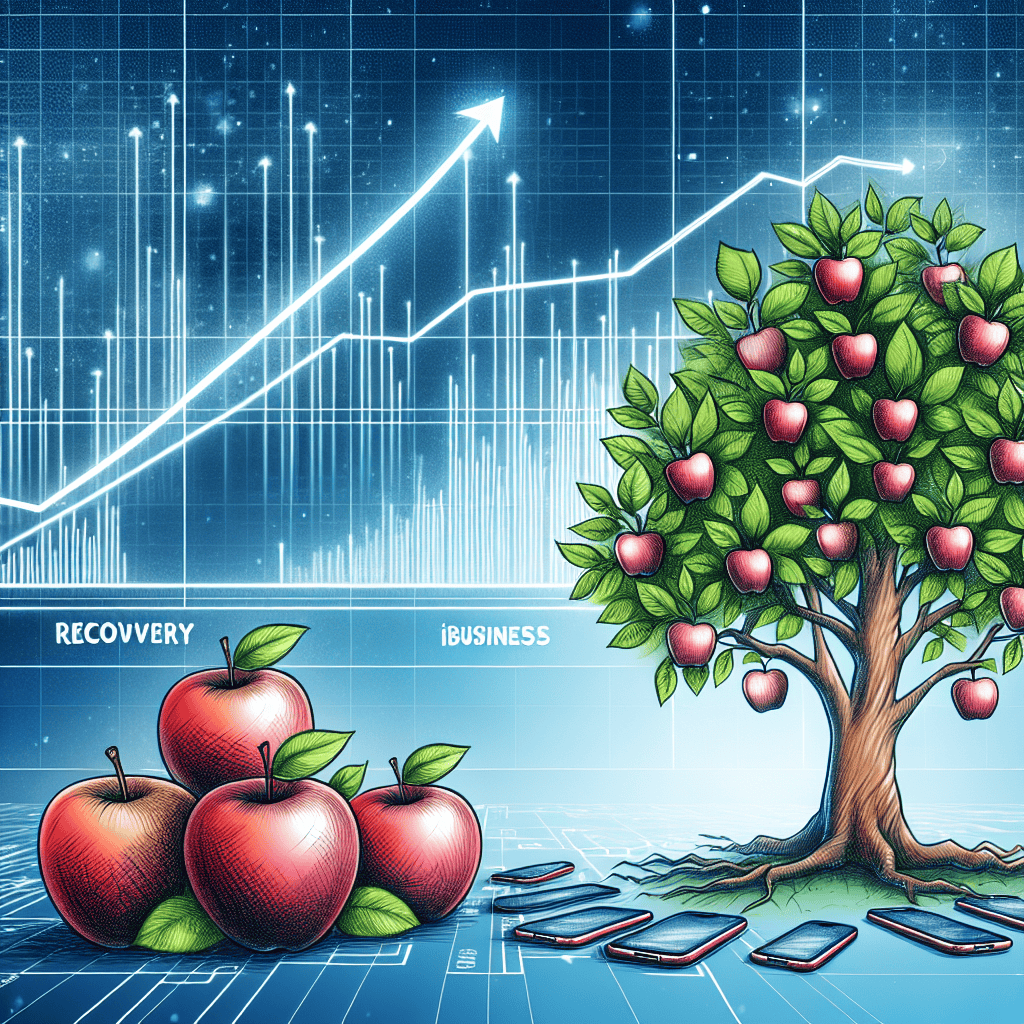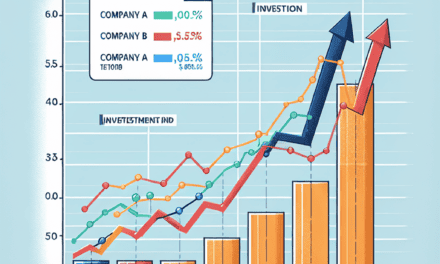“Apple Soars: iPhone Comeback Fuels Record-Breaking Sales Quarter!”
Introduction
In a remarkable demonstration of resilience and innovation, Apple Inc. has reported record-breaking quarterly sales, driven by a robust recovery in its iPhone business. This achievement underscores the company’s ability to navigate market challenges and capitalize on consumer demand for its flagship product. The surge in iPhone sales not only highlights Apple’s strategic prowess in product development and marketing but also reflects a broader consumer confidence in the brand’s ecosystem. As Apple continues to expand its technological horizons, this milestone sets a promising precedent for future growth and market leadership.
Apple’s Record-Breaking Quarterly Sales: A Deep Dive into the iPhone Business Recovery
In a remarkable turn of events, Apple Inc. has reported record-breaking quarterly sales, driven primarily by a robust recovery in its iPhone business. This achievement marks a significant milestone for the tech giant, which has faced numerous challenges in recent years, including supply chain disruptions and increased competition in the smartphone market. The latest financial results underscore Apple’s resilience and strategic acumen in navigating a complex global landscape, while also highlighting the enduring appeal of its flagship product, the iPhone.
The resurgence of Apple’s iPhone business can be attributed to several key factors. First and foremost, the company has successfully capitalized on the growing demand for 5G-enabled devices. With the rollout of 5G networks gaining momentum worldwide, consumers are increasingly seeking smartphones that can leverage the enhanced speed and connectivity offered by this next-generation technology. Apple’s latest iPhone models, equipped with 5G capabilities, have positioned the company to meet this demand effectively. By offering a range of devices that cater to different price points and consumer preferences, Apple has managed to capture a broad segment of the market, thereby boosting its sales figures.
Moreover, Apple’s strategic focus on innovation and product differentiation has played a crucial role in the iPhone business recovery. The company has consistently introduced cutting-edge features and improvements in its devices, such as advanced camera systems, enhanced battery life, and superior processing power. These innovations not only enhance the user experience but also reinforce Apple’s reputation as a leader in technological advancement. As a result, consumers remain loyal to the brand, often opting to upgrade to the latest models despite the availability of cheaper alternatives from competitors.
In addition to product innovation, Apple’s adeptness in marketing and brand management has significantly contributed to its record sales. The company has cultivated a strong brand identity that resonates with consumers globally, characterized by a commitment to quality, design excellence, and a seamless ecosystem of products and services. This brand loyalty is further bolstered by Apple’s strategic retail initiatives, including the expansion of its online and physical store presence, which have made its products more accessible to a wider audience.
Furthermore, Apple’s ability to navigate supply chain challenges has been instrumental in sustaining its sales momentum. The company has demonstrated remarkable agility in managing component shortages and logistical disruptions, ensuring that its products reach consumers in a timely manner. This operational efficiency has not only mitigated potential revenue losses but also reinforced consumer confidence in Apple’s reliability as a supplier.
While the iPhone business recovery has been a significant driver of Apple’s record quarterly sales, it is important to acknowledge the role of the company’s broader ecosystem in this success. Apple’s services segment, which includes offerings such as the App Store, Apple Music, and iCloud, continues to generate substantial revenue, complementing the hardware sales. This diversified revenue stream not only enhances Apple’s financial stability but also strengthens its competitive position in the tech industry.
In conclusion, Apple’s achievement of record quarterly sales is a testament to its strategic foresight, innovative prowess, and operational excellence. The recovery of its iPhone business, fueled by the demand for 5G technology, product innovation, and effective brand management, has been pivotal in this success. As Apple continues to navigate the evolving technological landscape, its ability to adapt and innovate will remain key to sustaining its growth trajectory and maintaining its status as a global leader in the tech industry.
How Apple’s iPhone Business Recovery Contributed to Record Quarterly Sales
In the latest financial quarter, Apple Inc. has reported record-breaking sales, a feat largely attributed to the remarkable recovery of its iPhone business. This achievement underscores the company’s resilience and strategic acumen in navigating a highly competitive and rapidly evolving technology market. The resurgence of the iPhone segment, which has historically been a cornerstone of Apple’s revenue, played a pivotal role in driving the company’s overall financial performance to new heights.
To understand the factors contributing to this recovery, it is essential to consider the strategic initiatives Apple has undertaken. Firstly, the introduction of the iPhone 15 series, with its innovative features and enhanced capabilities, has captivated consumers worldwide. The new models boast significant improvements in camera technology, processing power, and battery life, which have resonated well with both existing and new customers. Moreover, Apple’s commitment to sustainability, reflected in the use of recycled materials and energy-efficient components, has further bolstered the appeal of its latest offerings.
In addition to product innovation, Apple’s pricing strategy has been instrumental in revitalizing its iPhone sales. By offering a diverse range of models at varying price points, Apple has successfully catered to a broader audience, from budget-conscious consumers to those seeking premium experiences. This inclusive approach has not only expanded Apple’s customer base but also strengthened brand loyalty among its existing users. Furthermore, the company’s trade-in programs and financing options have made it more accessible for consumers to upgrade to the latest models, thereby driving sales growth.
Another critical factor in the iPhone business recovery is Apple’s robust global distribution network. The company has strategically expanded its presence in emerging markets, where smartphone penetration is still growing. By establishing partnerships with local carriers and retailers, Apple has effectively increased its market share in regions such as India and Southeast Asia. These efforts have been complemented by targeted marketing campaigns that emphasize the unique features and benefits of the iPhone, thereby enhancing brand visibility and consumer engagement.
Moreover, Apple’s ecosystem of products and services has played a significant role in the resurgence of its iPhone business. The seamless integration of the iPhone with other Apple devices, such as the Apple Watch, iPad, and Mac, creates a compelling value proposition for consumers. This interconnected ecosystem not only enhances user experience but also encourages customers to remain within the Apple family, thereby driving repeat purchases and fostering long-term loyalty.
The recovery of Apple’s iPhone business has also been supported by favorable macroeconomic conditions. As global economies continue to recover from the disruptions caused by the COVID-19 pandemic, consumer confidence and spending have rebounded. This positive economic environment has provided a conducive backdrop for Apple’s sales growth, as consumers are more willing to invest in premium technology products.
In conclusion, Apple’s record quarterly sales are a testament to the successful recovery of its iPhone business. Through a combination of product innovation, strategic pricing, global expansion, and ecosystem integration, Apple has effectively revitalized its flagship product line. As the company continues to navigate the challenges and opportunities of the technology landscape, its ability to adapt and innovate will remain crucial in sustaining its growth trajectory and maintaining its position as a leader in the industry.
The Impact of iPhone Innovations on Apple’s Record Quarterly Sales
In the latest financial quarter, Apple Inc. has reported record-breaking sales, largely driven by a resurgence in its iPhone business. This remarkable achievement underscores the significant impact of recent innovations in the iPhone lineup, which have not only revitalized consumer interest but also strengthened Apple’s position in the highly competitive smartphone market. As the company continues to push the boundaries of technology, the latest iPhone models have introduced a range of features that have resonated well with consumers, thereby contributing to the impressive sales figures.
One of the key innovations that have fueled this recovery is the introduction of advanced camera systems. With each new iteration, Apple has consistently enhanced the photographic capabilities of its devices, appealing to both amateur and professional photographers. The latest models boast improved low-light performance, enhanced image stabilization, and sophisticated computational photography features. These advancements have set a new standard in mobile photography, making the iPhone a preferred choice for users who prioritize camera quality.
Moreover, Apple’s commitment to sustainability has also played a crucial role in driving sales. The company has made significant strides in incorporating recycled materials into its products and reducing its carbon footprint. This focus on environmental responsibility has resonated with a growing segment of eco-conscious consumers who are increasingly considering sustainability in their purchasing decisions. By aligning its product development with these values, Apple has not only attracted new customers but also strengthened its brand loyalty among existing users.
In addition to hardware improvements, Apple’s software ecosystem continues to be a major draw for consumers. The seamless integration between iOS and other Apple devices creates a cohesive user experience that is difficult for competitors to replicate. Features such as iCloud, AirDrop, and Continuity allow users to effortlessly transition between their iPhone, iPad, and Mac, enhancing productivity and convenience. This interconnected ecosystem has become a significant selling point, encouraging users to remain within the Apple family of products.
Furthermore, the introduction of 5G technology in the latest iPhone models has been a pivotal factor in the sales surge. As global 5G networks expand, consumers are eager to experience the faster speeds and improved connectivity that this technology offers. Apple’s timely adoption of 5G has positioned the iPhone as a future-proof device, appealing to tech-savvy consumers who are keen to stay ahead of the curve. This strategic move has not only attracted new customers but also prompted existing users to upgrade their devices.
Additionally, Apple’s focus on privacy and security has become increasingly important in an era where data protection is a top priority for consumers. The company’s commitment to safeguarding user information through features like App Tracking Transparency and end-to-end encryption has differentiated it from competitors and reinforced consumer trust. This emphasis on privacy has become a compelling selling point, particularly as digital privacy concerns continue to rise.
In conclusion, Apple’s record quarterly sales can be attributed to a combination of innovative hardware advancements, a robust software ecosystem, strategic adoption of new technologies, and a strong commitment to sustainability and privacy. These factors have collectively revitalized the iPhone business, driving consumer interest and solidifying Apple’s leadership in the smartphone industry. As the company continues to innovate and adapt to changing consumer preferences, it is well-positioned to maintain its momentum and achieve further success in the future.
Analyzing Apple’s Sales Strategy: Lessons from the iPhone Business Recovery

In the ever-evolving landscape of technology, Apple Inc. has consistently demonstrated its ability to adapt and thrive. Recently, the company achieved record quarterly sales, largely attributed to the remarkable recovery of its iPhone business. This achievement not only underscores Apple’s resilience but also offers valuable insights into its sales strategy, which can serve as a lesson for businesses across various sectors. By examining the factors that contributed to this success, we can better understand the strategic maneuvers that facilitated the resurgence of Apple’s flagship product.
To begin with, Apple’s focus on innovation has been a cornerstone of its strategy. The company has consistently pushed the boundaries of technology, ensuring that each new iteration of the iPhone offers significant improvements over its predecessors. This commitment to innovation was evident in the latest models, which featured cutting-edge technology such as advanced camera systems, improved battery life, and enhanced processing power. By continuously enhancing the product’s value proposition, Apple has managed to maintain consumer interest and drive sales, even in a highly competitive market.
Moreover, Apple’s strategic pricing played a crucial role in the iPhone’s recovery. Recognizing the diverse needs and financial capabilities of its global customer base, Apple introduced a range of models at varying price points. This approach not only broadened the appeal of the iPhone but also allowed the company to capture a larger market share. By offering premium models for tech enthusiasts and more affordable options for budget-conscious consumers, Apple effectively catered to a wide audience, thereby boosting sales across different segments.
In addition to product innovation and strategic pricing, Apple’s robust marketing efforts significantly contributed to the iPhone’s resurgence. The company has long been known for its compelling marketing campaigns, which emphasize the unique features and benefits of its products. Through a combination of traditional advertising, digital marketing, and strategic partnerships, Apple successfully communicated the value of its latest iPhone models to a global audience. This comprehensive marketing strategy not only heightened consumer awareness but also reinforced brand loyalty, encouraging existing customers to upgrade and attracting new users to the Apple ecosystem.
Furthermore, Apple’s emphasis on customer experience has been instrumental in driving sales. The company has invested heavily in its retail and online platforms, ensuring a seamless purchasing process for consumers. Apple’s retail stores, with their sleek design and knowledgeable staff, provide an immersive experience that allows customers to explore and interact with the products firsthand. Meanwhile, the company’s online store offers a convenient and efficient shopping experience, complete with personalized recommendations and easy-to-navigate interfaces. By prioritizing customer satisfaction at every touchpoint, Apple has fostered a loyal customer base that continues to support its products.
Lastly, Apple’s strategic supply chain management has been pivotal in meeting the increased demand for iPhones. The company has established strong relationships with suppliers and manufacturers, enabling it to efficiently scale production and ensure timely delivery of products. This capability was particularly crucial during the recent surge in demand, as it allowed Apple to capitalize on market opportunities without facing significant supply constraints.
In conclusion, Apple’s record quarterly sales, driven by the recovery of its iPhone business, highlight the effectiveness of its multifaceted sales strategy. Through a combination of innovation, strategic pricing, robust marketing, exceptional customer experience, and efficient supply chain management, Apple has not only revitalized its flagship product but also set a benchmark for success in the technology industry. As businesses seek to navigate the complexities of today’s market, the lessons from Apple’s iPhone business recovery offer valuable insights into the importance of adaptability, customer-centricity, and strategic foresight.
The Role of Emerging Markets in Apple’s iPhone Sales Surge
In recent years, Apple has consistently demonstrated its ability to adapt and thrive in the ever-evolving global market. The company’s latest quarterly report, which highlights record-breaking sales figures, underscores this adaptability. A significant factor contributing to this success is the resurgence of its iPhone business, particularly in emerging markets. These regions have become pivotal in driving Apple’s growth, offering a wealth of opportunities that the company has strategically capitalized on.
Emerging markets, characterized by rapid economic growth and increasing consumer spending power, have become a focal point for many technology companies. For Apple, these markets represent a vast, untapped potential for expanding its customer base. The company’s recent success in these regions can be attributed to several key strategies. Firstly, Apple has made concerted efforts to tailor its products and marketing strategies to meet the unique needs and preferences of consumers in these areas. By offering a range of iPhone models at various price points, Apple has been able to appeal to a broader demographic, thereby increasing its market penetration.
Moreover, Apple’s investment in localized marketing campaigns has played a crucial role in enhancing brand visibility and consumer engagement. By understanding and respecting cultural nuances, Apple has been able to forge stronger connections with consumers, fostering brand loyalty and driving sales. Additionally, the company’s focus on building robust distribution networks in these regions has ensured that its products are readily accessible to consumers, further boosting sales figures.
Another critical factor contributing to Apple’s success in emerging markets is the growing demand for smartphones, driven by increasing internet penetration and the proliferation of digital services. As more consumers in these regions gain access to the internet, the demand for reliable and high-quality smartphones has surged. Apple’s reputation for producing premium devices with cutting-edge technology has positioned it as a preferred choice for many consumers seeking to upgrade their mobile experience.
Furthermore, the company’s strategic partnerships with local telecom operators have facilitated the adoption of iPhones in these markets. By collaborating with these operators, Apple has been able to offer attractive financing options and data plans, making its products more affordable and accessible to a wider audience. This approach has not only driven sales but also strengthened Apple’s competitive position in these regions.
In addition to these strategies, Apple’s commitment to sustainability and corporate social responsibility has resonated well with consumers in emerging markets. As environmental and social issues gain prominence globally, consumers are increasingly inclined to support companies that demonstrate a commitment to ethical practices. Apple’s efforts to reduce its carbon footprint and promote sustainable practices have enhanced its brand image, further contributing to its success in these regions.
In conclusion, the role of emerging markets in Apple’s iPhone sales surge cannot be overstated. By adopting a multifaceted approach that includes product diversification, localized marketing, strategic partnerships, and a commitment to sustainability, Apple has successfully tapped into the immense potential of these regions. As the company continues to innovate and adapt to the changing global landscape, emerging markets are likely to remain a key driver of its growth, propelling Apple to new heights in the competitive technology industry.
Apple’s Financial Triumph: Understanding the Factors Behind Record iPhone Sales
Apple Inc. has once again demonstrated its prowess in the technology market by achieving record quarterly sales, largely driven by a remarkable recovery in its iPhone business. This financial triumph underscores the company’s strategic acumen and its ability to adapt to changing market dynamics. Several factors have contributed to this impressive performance, each playing a crucial role in bolstering Apple’s position as a leader in the global smartphone industry.
To begin with, the introduction of the latest iPhone models has been a significant catalyst for Apple’s sales surge. The new devices, equipped with cutting-edge technology and innovative features, have captivated consumers worldwide. Apple’s commitment to enhancing user experience through improved camera systems, faster processors, and longer battery life has resonated well with both loyal customers and new adopters. Moreover, the company’s focus on sustainability, with the use of recycled materials and energy-efficient components, has appealed to environmentally conscious consumers, further boosting sales.
In addition to product innovation, Apple’s strategic pricing has played a pivotal role in driving iPhone sales. By offering a range of models at different price points, Apple has successfully catered to a diverse customer base. This approach has enabled the company to capture market share across various segments, from premium to mid-range smartphones. Furthermore, Apple’s trade-in programs and financing options have made it easier for consumers to upgrade to the latest models, thereby stimulating demand and contributing to the record sales figures.
Another factor contributing to Apple’s financial success is its robust global distribution network. The company has made significant investments in expanding its retail presence, both online and offline, to reach a wider audience. This expansion has been particularly effective in emerging markets, where the growing middle class is increasingly seeking high-quality smartphones. By establishing a strong foothold in these regions, Apple has been able to tap into new revenue streams and enhance its overall sales performance.
Moreover, Apple’s ecosystem of products and services has played an integral role in driving iPhone sales. The seamless integration of hardware, software, and services has created a compelling value proposition for consumers. Apple’s ecosystem encourages customer loyalty, as users are more likely to remain within the Apple family of products due to the convenience and compatibility offered. This interconnectedness not only boosts iPhone sales but also drives revenue from other segments, such as wearables and services, further solidifying Apple’s financial standing.
Furthermore, Apple’s adeptness in navigating supply chain challenges has been instrumental in maintaining its sales momentum. Despite global disruptions caused by the pandemic and geopolitical tensions, Apple has managed to secure a steady supply of components, ensuring timely production and delivery of its products. This resilience has allowed the company to meet consumer demand effectively, preventing potential sales losses due to inventory shortages.
In conclusion, Apple’s record quarterly sales, driven by the resurgence of its iPhone business, are a testament to the company’s strategic vision and operational excellence. Through product innovation, strategic pricing, global expansion, ecosystem integration, and supply chain management, Apple has successfully navigated the complexities of the modern market landscape. As the company continues to evolve and adapt, it remains well-positioned to sustain its growth trajectory and maintain its status as a dominant force in the technology industry.
Future Prospects: What Apple’s Record iPhone Sales Mean for the Tech Industry
Apple’s recent announcement of record quarterly sales, driven primarily by a resurgence in its iPhone business, has sent ripples throughout the tech industry, prompting analysts and competitors alike to reassess their strategies. This remarkable achievement not only underscores Apple’s resilience in a highly competitive market but also signals potential shifts in consumer behavior and technological trends that could shape the future of the industry. As we delve into the implications of this development, it becomes evident that Apple’s success is not merely a reflection of its innovative prowess but also a harbinger of broader changes within the tech landscape.
To begin with, Apple’s record sales highlight the enduring appeal of the iPhone, a product that has consistently set benchmarks for design, functionality, and user experience. The latest models, equipped with cutting-edge features such as advanced camera systems, enhanced processing power, and improved battery life, have resonated well with consumers, leading to a surge in demand. This resurgence is particularly noteworthy given the challenges posed by global supply chain disruptions and economic uncertainties. Apple’s ability to navigate these obstacles and deliver products that meet consumer expectations speaks volumes about its operational efficiency and strategic foresight.
Moreover, the success of the iPhone business has significant implications for the broader tech industry. As Apple continues to push the boundaries of smartphone technology, competitors are compelled to innovate and differentiate their offerings to maintain relevance. This competitive pressure is likely to accelerate advancements in areas such as artificial intelligence, augmented reality, and 5G connectivity, as companies strive to capture consumer interest and market share. Consequently, consumers can expect a wave of new and improved devices that enhance their digital experiences and offer greater value.
In addition to driving technological innovation, Apple’s record sales also underscore the growing importance of ecosystem integration. The seamless connectivity between Apple’s devices and services, such as iCloud, Apple Music, and the App Store, creates a compelling value proposition for consumers, encouraging them to remain within the Apple ecosystem. This strategy not only boosts customer loyalty but also generates recurring revenue streams, providing a stable financial foundation for future growth. As other tech companies seek to emulate this model, we may witness a shift towards more integrated and cohesive product ecosystems across the industry.
Furthermore, Apple’s achievement has broader economic implications, particularly in terms of job creation and investment. The company’s success translates into increased demand for components and services, benefiting suppliers and partners worldwide. This ripple effect can stimulate economic activity and foster innovation across various sectors, from semiconductor manufacturing to software development. As a result, Apple’s record sales could contribute to a more dynamic and resilient global tech economy.
Looking ahead, the future prospects for Apple and the tech industry appear promising. As consumer preferences evolve and new technologies emerge, companies that can anticipate and adapt to these changes will be well-positioned to thrive. Apple’s recent success serves as a testament to the power of innovation and strategic vision in navigating an ever-changing landscape. By continuing to invest in research and development, fostering strong partnerships, and prioritizing customer satisfaction, Apple and its peers can unlock new opportunities and drive the next wave of technological advancement.
In conclusion, Apple’s record quarterly sales with its iPhone business recovery not only reaffirm its status as a leader in the tech industry but also signal potential shifts that could redefine the competitive landscape. As the industry evolves, the lessons learned from Apple’s success will undoubtedly influence the strategies and priorities of tech companies worldwide, shaping the future of technology for years to come.
Q&A
1. **What was the key factor in Apple’s record quarterly sales?**
The recovery of the iPhone business was the key factor in Apple’s record quarterly sales.
2. **How did the iPhone business contribute to Apple’s sales?**
The iPhone business saw a significant recovery, driving a substantial portion of the overall sales increase.
3. **Did any other Apple products contribute to the record sales?**
While the iPhone was the primary driver, other products like the Mac, iPad, and wearables also contributed to the overall sales performance.
4. **What was the impact of the iPhone recovery on Apple’s market position?**
The recovery helped solidify Apple’s market position, reinforcing its dominance in the smartphone industry.
5. **Were there any specific regions where iPhone sales were particularly strong?**
iPhone sales were particularly strong in key markets such as the United States and China.
6. **How did Apple’s services segment perform during this period?**
Apple’s services segment continued to perform well, contributing to the overall revenue growth alongside hardware sales.
7. **What are the expectations for Apple’s future performance following this quarter?**
Expectations are optimistic, with analysts predicting continued growth driven by strong product demand and potential new product launches.
Conclusion
Apple’s record quarterly sales, driven by a recovery in its iPhone business, highlight the company’s robust market position and strategic acumen. The resurgence in iPhone sales suggests successful product innovation and effective marketing strategies, reinforcing Apple’s brand loyalty and consumer demand. This achievement not only underscores the resilience of Apple’s business model in a competitive tech landscape but also sets a positive outlook for future growth and profitability. The company’s ability to adapt and thrive amidst market challenges further solidifies its status as a leading player in the global technology industry.





